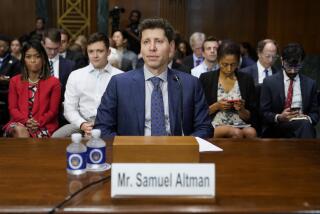Dreamer and Market Make a Grand Team
Takeover rumors about Control Data Corp. surfaced again last week--this time that the Belzbergs of Canada were buying into the Minneapolis maker of large computers.
But there was no confirmation from anybody, and most analysts thought the latest rumor would prove as insubstantial as others about Control Data in recent years. “The last one was spread by stock traders stirring the pot,” says analyst Don Young of the Sanford C. Bernstein research firm. The rumors recur, Young explains, because the company’s break-up value is probably more than $40 a share, while its current stock price is less than $27.
The question is, however, should such a company be subject to any kind of threat? Control Data happens to be a U.S. asset--the producer at the moment of the most powerful computer in the world. In other countries, there would be no chance of takeover. In this country, there is.
Is that an outrage, or is it--as supporters of the market system maintain--a strength of U.S. industry?
The fact is, the Control Data story supports the market. It is not a simple story, but it is a human one--a story of vision and fallibility and of the regenerative powers of a U.S. company.
It begins with William C. Norris, a Nebraska-born engineer, who founded the company in 1957. He and his associates, most of whom had left the old Sperry-Univac company, raised seed capital by selling stock at $1 a share in garages and high school gyms.
Their young company was a great success, specializing in large computers for science and engineering.
And its technical merit got an assist from Norris’ combativeness. In 1968, when IBM invaded Control Data’s scientific market, Norris sued on grounds of unfair sales practices. And Norris won--IBM settled out of court in 1973, paying Control Data $96 million.
Norris was unusual. When his chief computer designer, Seymour Cray, left to found Cray Research in 1973, Control Data backed him. “Had we been the usual, hard-nosed company, we’d have sued him,” said Norris years later. “But I don’t believe in that. Seymour made a great contribution to this firm, and so we invested in him.”
Investment Paying Off
Norris made mistakes, too. As his company entered the 1980s, Norris devoted more of its efforts--and financing--to developing a computerized teaching system called Plato. His vision went beyond dollars and cents, seeing Plato as a way to educate the poor. He defined his company’s market as “society’s unmet needs” and Control Data set up operations in the poorest neighborhoods.
But he cut no ice on Wall Street, which said the company was declining. And Wall Street was right. For while Norris pursued other goals, his computer divisions “didn’t bring out new products and lost market share,” recalls analyst Gary Smaby of Piper, Jaffray & Hopwood, the brokerage firm.
Eventually, as earnings fell, Control Data had to sell stock in its supercomputer division to raise money for research.
Norris, who is now 76, retired soon after that stock sale, and losses followed as Control Data reorganized. But one of its first acts was to buy back the stock of the supercomputer division--and it has since invested more than $200 million to develop a new series of computers.
That investment is paying off. One of those computers, the fastest in the world, can do 10 billion calculations per second--and mathematically simulate a wind tunnel to test an airplane. Another, at less than $1 million, is the world’s least expensive supercomputer. The company expects to sell 40 to 50 of the giants this year and is profitable again. “Control Data has turned the corner,” says analyst Frederick Wise of Bear, Stearns & Co. The market hasn’t recognized that yet, but the Belzbergs may have.
Moral of the story? Not that Norris or the market was right or wrong, but that together they gave us Control Data, Cray Research and related firms and ultimately U.S. leadership in supercomputers.
On the other hand, the market still has to catch up with Norris’ vision of educating the poor.






